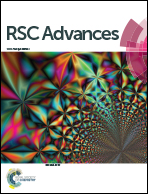Application of gas chromatography-mass spectrometry and chemometrics methods for assessing volatile profiles of Pu-erh tea with different processing methods and ageing years†
Abstract
Volatile changes and the post-fermentation ageing process of tea remain largely unknown. Additionally, the understanding of ageing and storage processes of tea mostly rely on sensory experience and lack the support of scientific and accurate data. In this paper, a method was developed based on head-space solid phase microextraction/gas chromatography-mass spectrometry (HS-SPME/GC-MS) combined with multivariate statistical methods to assess volatile profiles in different types of Pu-erh teas, including raw, ripe and aged Pu-erh teas. A total of 122 aroma components were identified in 57 Pu-erh teas. Differences in the manufacturing method and years in storage of Pu-erh teas resulted in different compositions and contents of volatile components. The characteristic volatiles in aged teas were hexadecanoic acid, dihydroactinidiolide, caffeine, linalool, 6,10,14-trimethyl-2-pentadecanone, β-ionone, cedrol, and phytol; the characteristic volatiles in raw teas were linalool, tridecane, caffeine, dihydroactinidiolide, β-ionone, 6,10,14-trimethyl-2-pentadecanone, dodecane, etc.; and the characteristic volatiles in ripe teas were 1,2,3-trimethoxybenzene, hexadecanoic acid, 1,2,4-trimethoxybenzene, dihydroactinidiolide, 6,10,14-trimethyl-2-pentadecanon, caffeine, and 1,2,3-trimethoxy-5-methyl-benzene. Through principal component analysis (PCA), clustering analysis (CA) and orthogonal projection to latent structures-discriminate analysis (OPLS-DA), three different kinds of Pu-erh teas were classified successfully. Additionally, aged Pu-erh teas showed similar volatile constituents as ripe teas. This study suggested that HS-SPME/GC-MS combined with chemometrics methods is accurate, sensitive, fast, universal and ideal for rapid routine analysis and discrimination of Pu-erh teas with different processing technologies and storage times.


 Please wait while we load your content...
Please wait while we load your content...